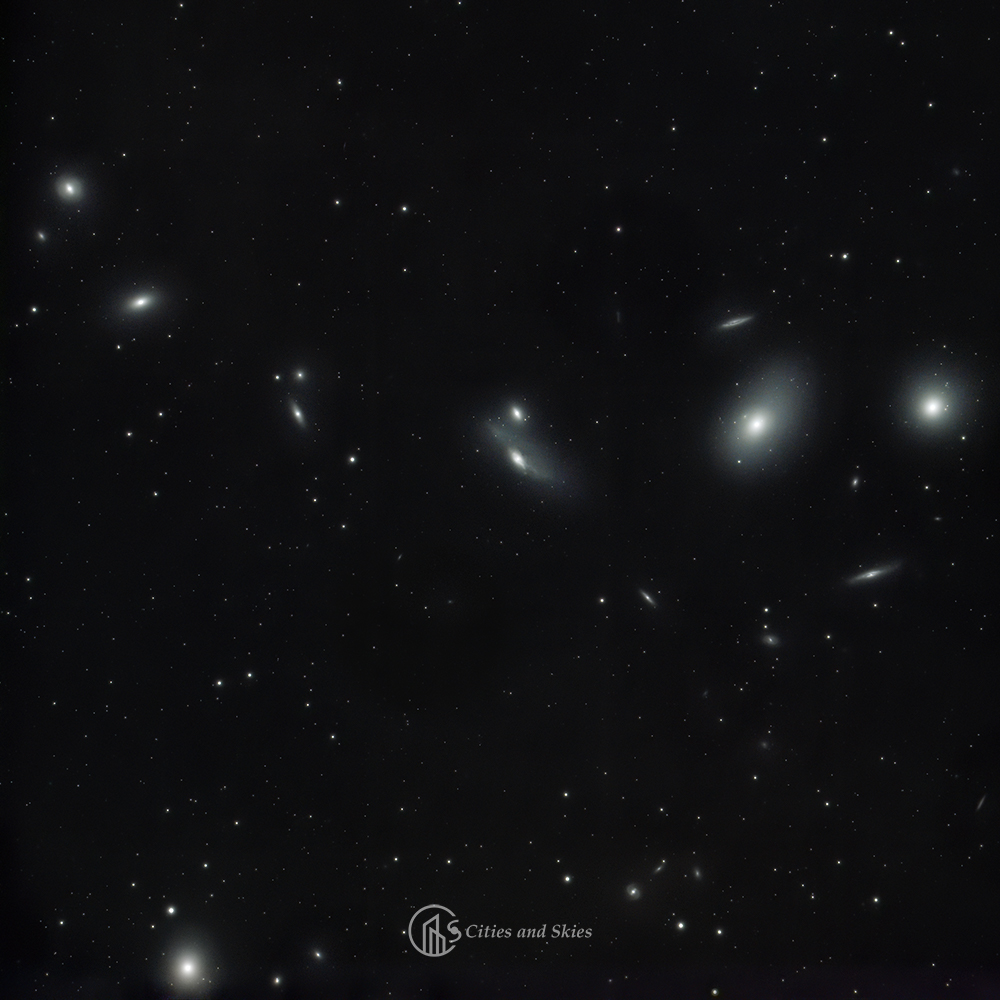Galaxies and supermassive black holes are intimately related: every galaxy has one in its center. Galaxies are the greatest structures that can be formed by stars, they contain billions of them. While black holes are the densest objects in the Universe, they are confined to a very tiny space compared to galactic scales. Still, galaxies and supermassive black holes have a very strong impact on each other’s evolution.
Markarian’s Chain
Galaxies are not even the largest structures in the Universe. They may appear in pairs or small groups but form huge clusters as well. These clusters are arranged in a filamentary structure around voids of space. In the picture above we see a chain of galaxies in the Virgo Cluster. It was named after an Armenian astronomer who showed they are floating together in space. Markarian’ Chain itself has two pairs of galaxies in the middle. It is a favorite astrophoto target because one may catch galaxies of different types in a single shot. Look also for the faint, fuzzy spots in the starry field!
Galaxies and Supermassive Black Holes
Most astrophotos however do not show the massive elliptical galaxy M87 (in the bottom left). It is the most massive member of the Virgo Cluster, right in the center. What is more, it contains an Active Galactic Nucleus, although it is not trivially seen in optical images like this. As we said above, galaxies and supermassive black holes go together. Supermassive black holes are fed by gas in the interstellar matter, in a process called accretion. This is the source of energy that turns some of the central black holes into an Active Galactic Nucleus. These nuclei may then power large-scale outflows that perturb the gas reservoirs of star formation. This is why the evolution of galaxies and supermassive black holes are so tightly linked.
The most famous black hole
Optical images may hint at Active Galactic Nuclei in galaxies, but usually, it takes observations at a range of wavelengths to discover and study them in detail. Radio waves travel through dust and gas largely unaffected, revealing the hidden nuclei of galaxies. When radio telescopes are combined all over the world in the technique of Very Long Baseline Interferometry (VLBI), they provide images with the finest detail in astronomy. This is actually what I do for a living. Although personally I have not been involved in this research, I have to show here the newest image of the most famous supermassive black hole, which is located right in the center of M87:

Credit: EHT Collaboration
The picture was made by the Event Horizon Telescope (a VLBI network working at high radio frequencies) and shows how light is polarized in the accretion disk around the black hole. This informs us about the magnetic fields near the black hole horizon, which play an important role in feeding and powering Active Galactic Nuclei.
For more information, follow the links in the JIVE press release here.
Higher resolution image (of our own Markarian’s Chain picture)
Observing log
Right after finishing with the Orion Nebula, switched filters and turned the telescope towards constellation Leo. We centered our frames on the pair of the “Eyes galaxies” of Markarian’s Chain; M87 we could just barely fit in. Started a run with 60*5min subs with gain 101. The elevation was still a bit low, and we had disturbing street lights in the front of the house. Unfortunately, the first hour and also the last half an hour or so had to be deleted (finished after 6 am). The night before we did the first run for M81-M82. These were our first deep galaxy shots beyond the Local Group of galaxies. Rare to have two moonless, totally clear winter nights, with 10-11 hours of continuous shooting!
Markarian’s Chain and M87 in the Virgo Cluster ~3.5h
Hoogeveen, Netherlands
13-14 Feb. 2021, Moonless, clear night!
Shot 60x300s but used only 42 or so
William Optics GT81, f/5.9
Flattener 6AIII 0.8x
ZWO ASI533MC-P, gain 101, -20 deg.
WO Uniguide 50/200 with ASI120MMmini
iOptron CEM40
Optolong L-Pro
ASIair
Bortle~5 (our region; in the town, it should be worse)
New Moon
Astro Pixel Processor (trial version), Photoshop
